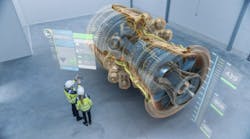By John Janevic, chief operating officer with MSC Software
No matter the industry they belong to, our customers tell us the same story of conflicting demands and increased pressure to do more with less. The manufacturing industry is facing a series of competing high-level demands, from regulatory pressures to improved carbon efficiency and pressure to control costs in an uncertain economic climate. This is coupled with conflicting pressures from customers for greater miniaturization, electrification and additional hi-tech functionality.
The situation isn’t getting easier any time soon. Downward pressure on manufacturing costs will only increase, with leading aerospace firms such as Airbus forced to cut jet production and a parallel reduction in automotive production by carmakers from Peugeot to Volkswagen caused by the slump in car sales across Europe. The COVID-19 pandemic has exacerbated what was already a challenging environment for manufacturers.
Simultaneously, environmental pressures are creating a need for rapid technological innovation. This is driving up development costs, leading to price increases for customers that must be justified with further innovation to maintain margins. Take electric cars, which are being designed not only to achieve zero-carbon, but also to deliver the price, range and charging convenience customers require. Meanwhile, aircraft manufacturers must design for more fuel-efficient journeys and noise reduction at a time when the air travel industry is under threat from international travel restrictions.
The automotive and aerospace sectors are the most prominent examples of recent industrial strife, but we’ve seen manufacturers across every industry face the same dilemma of having to deliver more innovative products at a greater rate and a lower cost than ever before.
Yet doing more with less is the very essence of innovation, and the current pressure to achieve this could drive a step in change design, engineering and production approaches. For the only way to achieve ‘lean’, cost-efficient innovation is to create more lean and efficient development strategies.
The challenge is that manufacturing methods and processes are fragmented across various proprietary tools and associated specialties. This limits multi-functional collaboration and the simultaneous use of tools across different physics or stages of development. Emerging smart-manufacturing workflows are dependent on innovation in the application of Computer Aided Engineering (CAE) and simulation at the design phase, but software licensing and old-fashioned processes make it difficult to retrofit legacy workflows within an organization.
Fragmented processes also mean fragmented data, and this hampers the kind of integrated, efficient development needed to bring new ideas to market. Leading manufacturers are aware of the need to build product-development workflows that facilitate greater collaboration between engineering specialisms and between design engineering and production. This boosts innovation by giving manufacturers the foresight to build ‘first time right’ products at design stage.
The key to this kind of agility and confidence is the effective use of CAE. But to deliver on its promise, it must be applied beyond its design-engineering roots to provide insights ranging from predicting a material’s behavior through to the cost, performance and sustainability of the manufactured product.
Many of the decisions affecting overall cost have already been committed in the design phase. This means there is also the opportunity to sidestep blue-sky concepts and get basic parameters right earlier in the process. Today CAE can help us estimate the cost of tooling and materials or predict the performance of an aerospace composite as manufactured so we don’t over-engineer parts by treating them as black metal. In this way, subsequent engineering disciplines and production teams aren’t left to break the bad news and revise the design. If materials and manufacturing methods are selected within the necessary cost or engineering constraints at the design phase, then innovation and productivity come hand-in-hand. Moreover, optimizing early drives efficiencies further down the production line, reducing dependence on prototyping and physical testing.
One way we have addressed this challenge of fragmented development is with MSCOne, a token-based product access platform that enables engineers to use any tools in any combination through universal tokens. It also gives access to e-learning through the same tokens, so that engineers can deploy a pick-and-mix of tools on a case-by-case basis and learn new skills and tools ‘on the job’.
This approach provides engineers with a ‘one stop shop’ to access a full spectrum of CAE software and break down some of their product development and manufacturing silos to create more integrated and streamlined processes, without the need to manage multiple licenses. We think universal access to tools and technologies from different specialisms recognizes an industry need to support multi-disciplinary engineers and fuel innovation to create something altogether new.
With development teams having access to any solution, they will be able to predict the impact of design decisions on every part of the process. Users can create, test and perfect every aspect of product development in simulation, from material design to structures, acoustics and fluid dynamics to manufacturing process design and fatigue analysis.
Take an electric vehicle powertrain, for example. A team can rapidly explore the efficiency of different configurations and swap out parts from several suppliers, then analyze its acoustic performance and thermal performance and durability without procuring new licenses. The goal is not to circumvent specialists, but to provide large or small organizations with the agility to give engineers the best tool for the job whenever they need it.
Our customers were wary of change at first. Some teams are so invested in their preferred tool that they could not see the benefits of token-based access to other tools. On the other hand, we saw VPs of engineering implementing strategies for extensive use of CAE for virtual testing and optimization across disciplines. But in our experience, organizations really learn the benefits when they encounter a new challenge, be it the pandemic-disrupting development teams and squeezing budgets or electric-vehicle development requiring the mechanical engineer to consider the drag or electrical efficiency of a new vehicle.
It’s really encouraging for the industry that we are embracing change. We need skilled engineers more than ever, but we also need to break down silos between disciplines and between the stages of product development. As a technology vendor, we have technologies that can help manufacturers make smarter decisions at every step, but we would never pretend to have the optimal solution to every challenge in every industry. That’s why we opened up our MSCOne platform to technology partners so customers can build solutions on demand without the risk and inconvenience of procuring more rigid annual licenses from additional suppliers.
Ultimately, this single portal to an ecosystem of tools is designed to enable more streamlined, integrated product-development processes, speeding up production cycles and lowering costs. It is part of a growing trend in simulation where larger OEMs need to provide instant access to simulation to boost innovation.
A smaller startup or supplier needs more cost-effective ways access powerful tools without taking on unnecessary financial risk. For example, a PCB designer may not use computational fluid dynamics regularly, but being able to test the thermal design of their circuit board within a customer’s enclosure on their laptop could win them a contract.
Conflicting pressures have exposed many of the organizational challenges facing the manufacturing industry. If we are to do more with less and adapt quickly to new challenges, we need teams to implement workflows that are as multi-functional, agile and cost-efficient as the products they are increasingly required to produce.


